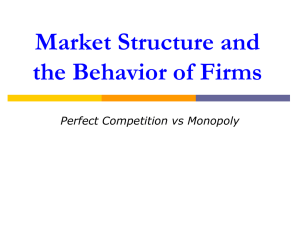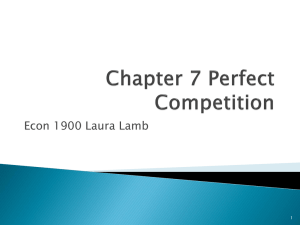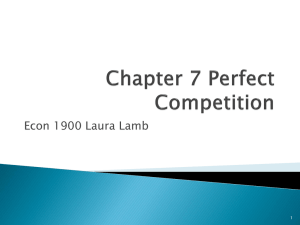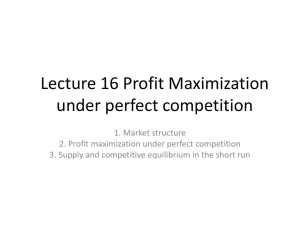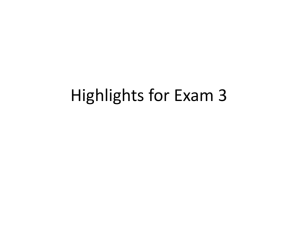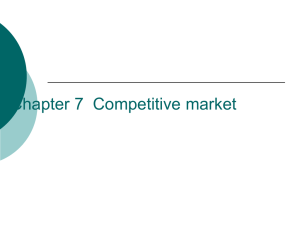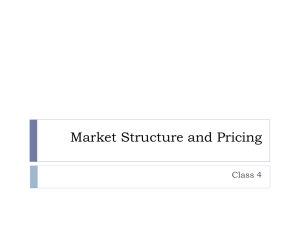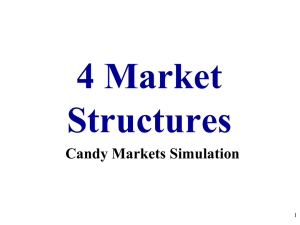Firms and Competitive Markets
advertisement
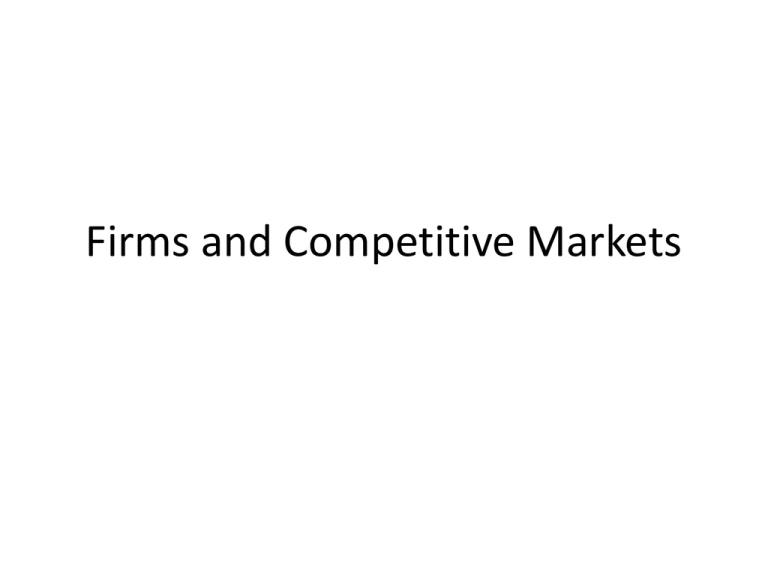
Firms and Competitive Markets Competitive Market • Properties – Many buyers and sellers – Trading identical products – Each buyer and seller a price taker – Free entry/exit of the market • Goal is to maximize profit – ∏ = TR - TC • Total Revenue – Price time quantity: TR = P x Q • Average Revenue – Total Revenue divided by quantity sold • Marginal Revenue – Change in revenue from additional unit sold • For competitive firms – Average Revenue = P – Marginal Revenue = P Profit Max • Profit Maximization – Produce at the quantity that maximizes the difference between TR and TC – Compare marginal revenue with marginal cost • If MR > MC increase production • If MR < MC decrease production • If MR = MC profit maximized Profit Max Decision Costs and Revenue Producing here MC > MR so don’t MC ATC MC = MR so profit maxed AVC P = MR = AR Producing here MC < MR so produce more Q* Quantity • Marginal Cost Curve (MC) determines the quantity a firm would be willing to supply at a given price • Therefore it is the firms supply curve MC Curve as Supply Curve Costs and Revenue MC ATC P2 AVC P1 Q1 Q2 Quantity Shut down and Exit • Shut Down – Short Run decision not to produce – Still have to pay fixed costs though • Exit (don’t Enter) – Long Run decision – No costs Short Run Decision • Focus on – Total Revenue – Variable costs (fixed costs are fixed, so ignore) • Decision – Shut down if TR < VC ( or MR/AR < AVC ) • Competitive Firms Short Run Supply Curve – MC curve above the AVC curve Short Run Supply Curve Costs ATC In short run firms produce on the MC curve if P > AVC MC AVC Quantity In short run firms shut down if P < AVC Long Run Decision • Exit Market if: – TR < TC – Or P < ATC • Enter Market if: – TR > TC – Or P > ATC • Competitive Firms Long Run Supply Curve – Portion of the MC curve above the ATC curve Long Run Supply Curve Costs ATC MC In long run firms produce on MC curve if P > ATC Firms exit market if P<ATC Quantity Profit • If P > ATC – Positive profits – ∏ = TR – TC = (P – ATC) x Q • If P < ATC – Negative profits (losses) – Loss = TC – TR = (ATC – P) x Q Firm with Profits Firm with Losses AVC AVC MC MC Profit P Loss AVC AVC P Profit Maximizing Q Q* Q* Cost Minimizing Q Market Supply Curve • In short run # of firms fixed • Each firm supplies where P = MC • Each firms supply curve is the MC curve above their AVC curve (otherwise 0) • For market supply just add up horizontally S1 S2 + S - Market = • In long run # of firms not fixed – Free entry/exit • If P > ATC – Profits are positive – Firms enter market • If P < ATC – Firms taking losses – Firms exit the market • This means all firms (assuming identical cost curves) will produce at MC = ATC (efficient pt) – So MKT supply curve will be horizontal at that point (perfectly elastic) Long Run Market Supply Multiple Firms with identical cost curves Add up supply at MC = ATC level for each to get Market Supply Price Price ATC MC P= Min ATC Supply Quantity Quantity Some Caveats P P Actual Supply would be more like this, with holes and dots denoting when different firms enter. That is it would not be a smooth line. And perhaps it could still slope up if by increasing market size they bid up the cost of inputs. This would cause latte entering firms to have higher cost curves. Or some firms could just be better at it, thus having lower cost curves. But either way LR flatter than SR. Q Q • • • • So why stay in business if making zero profit? Profit = Total Revenue – Total Costs Total Costs include opportunity costs Zero Profit Equilibrium – Zero economic profit – Positive accounting profit Shift in Demand and LR and SR supply response • Market in long run eq. – P = ATC – Zero economic profit • Increase in demand – Demand shifts out – Short Run • Higher quantity, higher price • P > ATC • Positive economic profit • • • • • • Because of positive profits Firms enter in the long run SR supply curve shifts right Price falls back to low point on ATC Quantity increases (because of more firms) Back to efficient scale Initial State of Equilibrium Market Firm P P D SR Supply ATC MC P’ LR Supply Q’ Q Q Demand Shifts, + Profits Market Firm P P D Price increases SR Supply ATC MC Which leads to + profits P’’ LR Supply Q Q Supply Shifts, 0 Profits Market P Firm SR Supply D Profits induce firms to enter market P’’’ P ATC MC Restoring Long Run Equilibrium, but with more firms Price falls back Q Q

